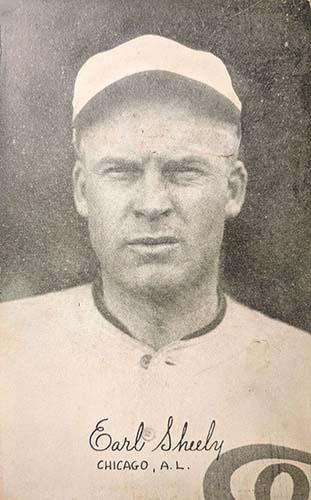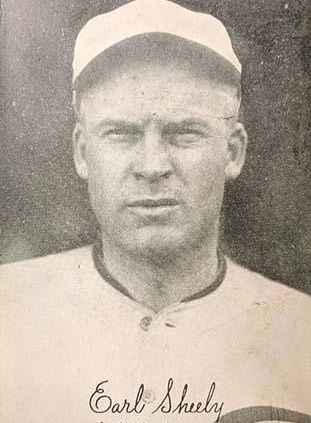July 9, 1921: White Sox rally from 8-run deficit, beat Yankees 10-9 in 16 innings
 The seventh-place Chicago White Sox generated some welcome excitement for 25,000 fans at Comiskey Park on July 9, 1921. The White Sox weren’t doing much against the American League in general, but they had a handle on the New York Yankees, with six wins in nine head-to-head games so far in 1921. Eventually they were 13-9 against the New Yorkers and thus were the only team with a winning record against them that year. The visitors had never won a pennant, but despite their problems with the White Sox, were in the title hunt – they stood two games behind the defending World Series champion Cleveland Indians. The 31-44 White Sox, just two seasons removed from their infamous “Black Sox” World Series, were lagging just a half-game ahead of the cellar-dwelling Philadelphia Athletics.
The seventh-place Chicago White Sox generated some welcome excitement for 25,000 fans at Comiskey Park on July 9, 1921. The White Sox weren’t doing much against the American League in general, but they had a handle on the New York Yankees, with six wins in nine head-to-head games so far in 1921. Eventually they were 13-9 against the New Yorkers and thus were the only team with a winning record against them that year. The visitors had never won a pennant, but despite their problems with the White Sox, were in the title hunt – they stood two games behind the defending World Series champion Cleveland Indians. The 31-44 White Sox, just two seasons removed from their infamous “Black Sox” World Series, were lagging just a half-game ahead of the cellar-dwelling Philadelphia Athletics.
The starting pitchers were a study in contrast. Chicago’s Cy Twombly (1-2, 6.20 ERA) was making what became the last start of his seven-game major-league career and he appeared in just two more games after the July 9 game. He had left Lehigh University to sign with the St. Louis Cardinals in 1918 but never played for them.1 He joined the White Sox in mid-June of 1921.2
He’d lasted only three innings in his last start, only two days before, and got off to an ominous start against New York by hitting leadoff batter Chick Fewster with a pitch and walking Roger Peckinpaugh. Babe Ruth popped out, but Frank “Home Run” Baker singled, scoring Fewster and sending Peckinpaugh to third. Bob Meusel’s sacrifice fly made it 2-0, Yankees.
Carl Mays (2.49 ERA) started for the Yankees. Pitching in his seventh major-league season, the extreme submariner was notorious for having fatally beaned Cleveland shortstop Ray Chapman a year earlier.3 He had already won 13 games in 1921, on his way to a major-league-leading 27 wins.4 He handled the Sox in the first. Ernie Johnson grounded out and Eddie Mulligan popped out to start the inning. Eddie Collins got an infield single, but Amos Strunk lined out for the third out.
Twombly’s struggles continued in the top of the second. A double by Fewster scored Aaron Ward, and Wally Schang scored on Peckinpaugh’s fly. The White Sox were down 4-0. It stayed that way after their scoreless half-inning and again after a scoreless third inning.
Twombly had seemed to be regaining some poise, but in the New York fourth, Ward beat out a bunt and moved to second on Schang’s single. Mays was hit by a pitch, loading the bases.
With his team in danger of being completely blown out, White Sox manager Kid Gleason summoned pitcher Jack Wieneke. It worked, temporarily, as Fewster popped out. Weineke got another out when Peckinpaugh grounded to shortstop Johnson, who forced Mays at second. But Ward scored on the play, and Ruth followed by singling Schang home. New York had added two runs and was now up 6-0.
The score remained that way until the top of the seventh, when the Yankees increased their lead again. Collins booted Baker’s groundball to open the inning. Meusel and Pipp flied out, but New York took advantage of the extra out. Ward doubled Baker home, and Schang singled Ward home. The Yankees had two more runs and led, 8-0.
Through six innings Mays had limited the White Sox to two hits, but they got things going in their half of the seventh. Strunk and rookie Bibb Falk nicked Mays for consecutive singles and Johnny Mostil was hit by a pitch to load the bases with no outs.
Mays got Earl Sheely on a popup for the first out. Schalk’s groundball forced Mostil at second, scoring Strunk and getting Chicago on the scoreboard.
Gleason sent out Red Ostergard to hit for Wieneke. Ostergard singled, driving in Falk and advancing Schalk to second. As the batting order flipped, Johnson’s single – the fourth of the inning – scored Schalk. Eddie Mulligan followed with another single, loading the bases for Collins. The merry-go-round ended there as he flied out. Chicago’s mild uprising had narrowed the gap, but they still trailed by five runs at 8-3.
Gleason sent out a new battery for the top of the eighth; Clarence “Shovel” Hodge relieved Wieneke and Yam Yaryan replaced Schalk behind the plate. The Yankees got an apparent insurance run on a single by Meusel that plated Fewster on a ball at least one Chicago writer considered a “bobble.”5
The White Sox did not quit. They rallied for two more runs in their half of the eighth. Strunk walked and scored when Falk tripled. Mostil’s groundout scored Falk. Mays got out of the inning without further damage, but the Yankees’ lead was down to 9-5.
Hodge shut down the Yankees in the ninth inning. As the White Sox came up for their last swings, he batted for himself and singled. Johnson singled him to second. Mulligan grounded to Ward to force Johnson for the first out, but Ward made a wild throw trying for a double play, allowing Hodge to score. Singles by Collins and Strunk scored another run, cutting the margin to 9-7 and putting Collins at second with one out.
Yankee manager Miller Huggins pulled Mays, who had been plunked for 12 hits, and replaced him with Waite Hoyt. “Mays went to the clubhouse with a lot of ‘boos’ echoing in his ears.”6
Falk singled Collins home to make it 9-8; Strunk moved to third base with the potential tying run. Hoyt got Mostil to roll to third base, where Frank Baker, with the play in front of him, threw Strunk out at the plate. But Falk advanced to second on the play; Chicago was still alive, albeit with two outs.
The White Sox capped their improbable comeback rally when Sheely singled to drive Falk home with the tying run. The four-run outburst was so intense for fans that it was reported to have played a role in the death of J.H. Green, taking in the game as a visitor from Omaha, Nebraska. “The heat and the excitement proved too grand and he collapsed to the floor. It was not until the end of the 9th inning that his huddled figure was noticed beneath the seat.”7 Hoyt finished the half-inning without further scoring, but the game moved into extra innings; the White Sox had once again given the Yankees fits, erasing an eight-run deficit in the last 2½ innings of regulation play.8
After both Hodge and Hoyt navigated the 10th inning successfully, the Yankees had an opportunity to retake the lead in the 11th. Meusel led off with a double. Pipp tried to advance him to third on a bunt, but Hodge fielded it and threw to third base to nip Meusel. Ward walked, moving Pipp to second. Schang singled to right field, but Strunk fielded it and threw to Yaryan, who tagged out Pipp and kept the game tied.
Having dodged that bullet, the White Sox had their own chance to win the game. Collins led off the 11th with a double. Strunk was unable to bunt him to third and flied out. Huggins had Hoyt issue Falk an intentional pass. With Mostil batting, Collins stole third base, giving Chicago runners on the corners with one out.
In danger of losing the game on any ball in play and with the Yankees infield drawn in, Hoyt dug in to strike out Mostil. He got Sheely on a groundout, ending the threat.9
Hoge and Hoyt continued to put zeroes on the scoreboard through the 12th, 13th, and 14th innings. Peckinpaugh singled to open the New York 15th, but Ruth – who entered the game batting .382 and came out of it at .375 after a 1-for-8 day – grounded into a double play. Baker kept things alive with a single; Hodge, now pitching in his eighth inning, got Meusel for the final out.10 The Yankees again threatened to score in the 16th inning. Pipp led off and was safe on Sheely’s error. Ward singled him to second. Schang’s groundball forced Ward at second, but Pipp advanced to third. Hoyt couldn’t get the bat on the ball on an attempted squeeze bunt, and Pipp was an “easy” out at home.11
Strunk, leading off, went down on a called third strike. Falk singled – his fifth hit of the day – and advanced to second when Mostil grounded out and Peckinpaugh failed to cover second.
Sheely then came through what the home fans wanted to see after the 3-hour, 18-minute epic, delivering “the bread-winning smash” as Falk romped home.12
Hodge got the satisfying 10-9 win with a yeoman effort – one run allowed on eight hits over nine innings in relief. Hoyt had allowed only two runs in his 7⅓ innings in relief of Mays, but the last one stuck him with the loss.
Sources and acknowledgments
In addition to the sources cited in the Notes, the author consulted Retrosheet.org and Baseball-Reference.com for player and team data and the box scores of this game. Retrosheet’s vault of information maintained for pending deduced play-by-play was useful; the author extends appreciation to Dave Smith of Retrosheet.
https://www.baseball-reference.com/boxes/CHA/CHA192107090.shtml
https://www.retrosheet.org/boxesetc/1921/B07090CHA1921.htm
Notes
1 Cy Twombly player card, The Sporting News Contract Card Collection, LA84.com, https://digital.la84.org/digital/collection/p17103coll3/id/122992/rec/4, accessed December 28, 2020.
2 I.E. Sanborn, “White Hose Home After Good Trip to Battle Indians,” Chicago Tribune, June 21,1921: 19.
3 Allan Wood, “Carl Mays,” SABR Baseball Biography Project, sabr.org, accessed December 28, 2020.
4 Mays and Urban Shocker of the St. Louis Browns each won 27 games in 1921 to lead both leagues.
5 I.E. Sanborn, “Sox Win Hot 16-Inning Game from Yanks,” Chicago Tribune, July 10, 1921: A1.
6 “Sox Win Hot 16-Inning Game From Yanks.”
7 “Fan at Sox Thriller Dies as Bibb Falk Ties Score in the Ninth,” Chicago Tribune, July 10, 1921: A1.
8 The White Sox finished 1921 with a 13-9 record against New York. The only other team against which they were .500 or better was league doormat Philadelphia.
9 “Notes,” Chicago Tribune, July 10, 1921: A2.
10 “Chicago Conquers Yanks in Sixteenth,” New York Times, July 10, 1921: 86.
11 “Chicago Conquers Yanks.”
12 Sanborn, “Sox Win Hot 16-Inning Game.”
Additional Stats
Chicago White Sox 10
New York Yankees 9
16 innings
Comiskey Park
Chicago, IL
Box Score + PBP:
Corrections? Additions?
If you can help us improve this game story, contact us.


